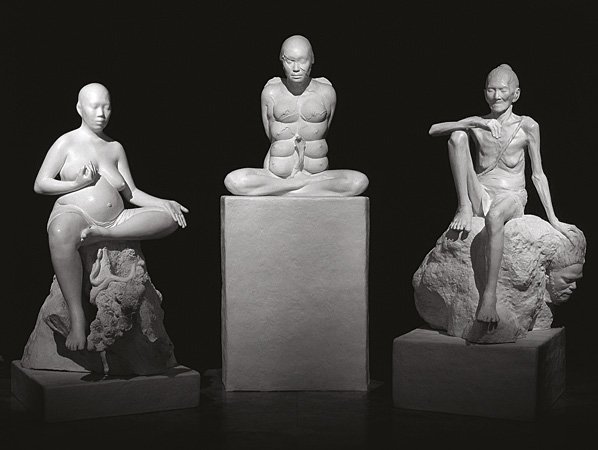Cultural Center of the Philippines
ENCYCLOPEDIA OF
PHILIPPINE ART
Tatlong Buddhang Ina
(Three Buddha Mothers) / 1995 / Plaster / Life-size / Artist: Agnes Arellano / Singapore Art Museum collection
This group of life-size sculptures is one example of Arellano’s “inscapes,” a term borrowed from English poet Gerard Manley Hopkins. Arellano uses the word in pertaining to the meaningful unity of form and concept.
Arellano’s visual vocabulary can confound the viewer uninitiated into her particular way of appropriating and repurposing images from multiple sources. This triumvirate of Buddha mothers—she has made a point of asserting that these, notwithstanding the similarity to the tripartite deity of maiden, mother, and crone, are not goddesses—is characteristic of her oeuvre, being replete with allusions to spiritual and personal themes. Her aim with this inscape is to underscore the need to search for the sacred in the mundane.
The central figure, Dea, is a fantasy self-portrait that ties in with difficulties that Arellano underwent in the experiences of giving birth by Caesarean section, becoming a mother, and also becoming a stepmother. Endowed with wings and four pairs of breasts, Dea appears to be in the midst of breaking out of her old skin. A cobra stands between her legs in a protective gesture, like how the Muchilinda, a gigantic serpent with several heads, is said to have shielded a meditating Gautama Buddha from a fierce storm with his hood. To the left is Vesta, a vessel of life who provides milk and honey as nourishment. She makes a gesture of generosity, and, upon her back, carries a large lizard, a symbol of fertility. To the right is Lola, who, by virtue of old age, is free from reproductive and sexual duties, and represents the promise of arriving at love lost through intellectual pride by way of turning inward.
Tatlong Buddhang Ina was exhibited at the 6th Havana Biennale in 1997 with Eshu, a floor piece depicting a deity of roads, especially crossroads, from the Yoruba religion. The four-legged, three-armed figure holds a bottle of wine and a cigar in his right hands, and a trident in his left. Eshu, according to Arellano, is like Dea, in that it functions as a fantasy self-portrait.
Written by Jaime Oscar M. Salazar
Sources
Arellano, Agnes. 2011c. “Three Buddha Mothers (Tatlong Buddhang Ina).” Agnes Arellano, Sculptor. http://www.agnesarellano.com/articles/aaabuddha.htm.
Datuin, Flaudette May. 2002a. Home Body Memory: Filipina Artists in the Visual Arts, 19th Century to the Present. Quezon City: University of the Philippines Press.
Greenblatt, Stephen et al., eds. 2006. “Gerard Manley Hopkins.” In The Norton Anthology of English Literature. 8th ed. Vol. 2. New York, London: W. W. Norton and Company.
Guillermo, Alice G.2011a. “Myths of Creation and Destruction.” Agnes Arellano, Sculptor. http://www.agnesarellano.com/articles/guillermo.htm.
